Supermassive Engines
Quasars, BL Lac objects, Seyfert galaxies, and radio galaxies are excellent examples of how astronomers can use one mechanism to explain an apparently wide variety of objects in space. In 1968, the British astronomer Donald Lynden-Bell (1935–) suggested that the gravitational field of a supermassive black hole (see Chapter 14) could cause the enormous releases of energy for quasars and other active galaxies.
17-4 Supermassive black holes exist at the centers of most galaxies
As we saw in Chapter 14, black holes with a wide range of masses are being discovered throughout the universe. Supermassive black holes (those exceeding a million solar masses or so) have been detected in a rapidly growing number of galaxies, including our Milky Way (see Chapter 16). To emphasize the similarities in active galaxies, we consider five further examples: M31, M32, M87, M104, and NGC 3115.
The Andromeda Galaxy (M31) is the second largest, second most massive galaxy in the Local Group (after the Milky Way). In the mid-1980s, several astronomers made careful spectroscopic observations of the core of M31. Using measurements of Doppler shifts, they determined that stars within 50 ly of the galactic core are orbiting the nucleus at exceptionally high speeds, which suggests that a massive object is located at the galaxy’s center. Without the gravity of such an object to keep the stars in their high-speed orbits, they would have escaped from the core region long ago. From such observations, astronomers estimate the mass of the central object in M31 to be about 50 million solar masses. That much matter confined to such a small volume strongly suggests that a supermassive black hole is located there.
Near M31 is a small elliptical galaxy, called M32 (Figure 17-13). High-resolution spectroscopy indicates that stars close to the center of M32 are also orbiting this galaxy’s nucleus at unusually high speeds, which is explained by the presence of a supermassive black hole there, too. A picture taken by the Hubble Space Telescope (Figure 17-13 inset) shows that the concentration of stars at the core of M32 is truly remarkable. Its number density of stars is more than 100 million times greater than the density of stars in the Sun’s neighborhood. The concentration of stars and their high speeds strongly support the belief that a supermassive black hole also exists at the center of M32.

Margin Question 17-4
Question
What makes it so hard for us to see deep into elliptical galaxies?
522
One early candidate galaxy for study by the Hubble Space Telescope was the giant elliptical galaxy M87 (Figure 17-14). Located some 50 Mly from Earth, M87 is an active galaxy that has long been recognized as unusual. In 1918, Heber Curtis at the Lick Observatory reported that the center of M87 has “a curious straight ray…apparently connected with the nucleus by a thin line of matter.” Figure 17-14 shows radio and visible images of M87 to scale. M87 is also a powerful source of X-rays. X-rays emitted by such small sources are a signature of black holes (as discussed in Section 14-7).
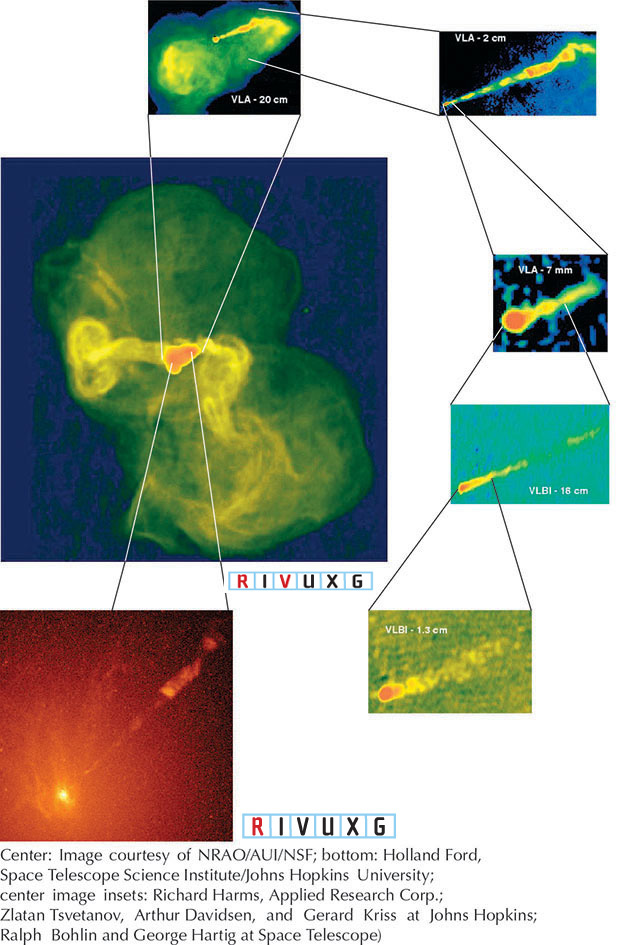
The Hubble Space Telescope image of M87 in Figure 17-14 shows an exceptionally bright, starlike nucleus and a surrounding disk of gas with trailing spiral arms. To produce this fiery glow, stars must be packed so tightly at the center of M87 that their density is at least 300 times greater than that normally found at the centers of giant ellipticals. The motions of the stars in this central clustering support the hypothesis that a black hole with nearly 3 billion M⊙ resides at the center of M87.
Even edge-on spiral galaxies are revealing their innermost secrets. John Kormendy (1948–) used a 3.6 m telescope on Mauna Kea to examine the core of M104 (Figure 17-15) spectroscopically. Once again, high-speed gas orbiting the galaxy’s nucleus was found. These observations suggest that the center of this galaxy is dominated by a supermassive black hole that contains a billion solar masses. Similar spectroscopic observations of the edge-on disk galaxy NGC 3115 also reveal evidence of a billion-solar-mass black hole at its core.

523
17-5 Jets of protons and electrons ejected from around black holes help explain active galaxies

 The gravitational energy associated with supermassive black holes at the centers of galaxies creates huge jets of gas comprised of protons and electrons. To see how this works, consider a black hole at the center of a young galaxy filled with gas and dust. Because the centers of galaxies are congested places, a black hole located there will capture a massive accretion disk of this debris (Figure 17-16a). If the black hole is not rotating (a Schwarzschild black hole) or if it is a slowly rotating Kerr black hole, then most of the mass approaching it from the accretion disk will spiral down into it. This does not last for long, because as this debris spirals in, the black hole gains angular momentum from the in-spiraling debris and therefore begins rotating faster and faster. By the time the black hole has doubled its original mass, its event horizon is whipping around at nearly the speed of light. The gas and dust spiraling towards a rapidly rotating Kerr black hole has much more difficulty entering the black hole because the motion of the black hole literally drags the space and the debris surrounding it around and around (see Section 14-5), thereby slowing the infall. The formation of jets occurs in this debris.
The gravitational energy associated with supermassive black holes at the centers of galaxies creates huge jets of gas comprised of protons and electrons. To see how this works, consider a black hole at the center of a young galaxy filled with gas and dust. Because the centers of galaxies are congested places, a black hole located there will capture a massive accretion disk of this debris (Figure 17-16a). If the black hole is not rotating (a Schwarzschild black hole) or if it is a slowly rotating Kerr black hole, then most of the mass approaching it from the accretion disk will spiral down into it. This does not last for long, because as this debris spirals in, the black hole gains angular momentum from the in-spiraling debris and therefore begins rotating faster and faster. By the time the black hole has doubled its original mass, its event horizon is whipping around at nearly the speed of light. The gas and dust spiraling towards a rapidly rotating Kerr black hole has much more difficulty entering the black hole because the motion of the black hole literally drags the space and the debris surrounding it around and around (see Section 14-5), thereby slowing the infall. The formation of jets occurs in this debris.
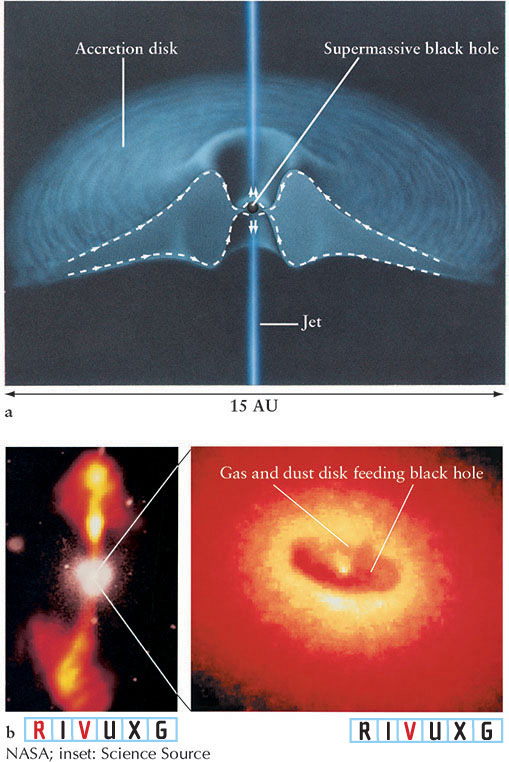

 Supermassive Black Holes as Engines for Galactic Activity (a) Analogous to the activity depicted in Figure 14-19, in the accretion disk around a supermassive black hole, inswirling gas heats and expands. pulled inward, compressed, and heated further, some of it is eventually expelled perpendicular to the disk in two jets. (b) The giant elliptical galaxy NGC 4261 is a double-radio source located in the Virgo cluster, about 100 million ly from Earth. An optical photograph of the galaxy (white) is combined with a radio image (orange and yellow) to show both the visible galaxy, which does not emit much radio energy, and its jets, which do. Inset: This hubble Space Telescope image of the nucleus of NGC 4261 shows a disk of gas and dust about 800 ly (250 pc) in diameter, orbiting a supermassive black hole.
Supermassive Black Holes as Engines for Galactic Activity (a) Analogous to the activity depicted in Figure 14-19, in the accretion disk around a supermassive black hole, inswirling gas heats and expands. pulled inward, compressed, and heated further, some of it is eventually expelled perpendicular to the disk in two jets. (b) The giant elliptical galaxy NGC 4261 is a double-radio source located in the Virgo cluster, about 100 million ly from Earth. An optical photograph of the galaxy (white) is combined with a radio image (orange and yellow) to show both the visible galaxy, which does not emit much radio energy, and its jets, which do. Inset: This hubble Space Telescope image of the nucleus of NGC 4261 shows a disk of gas and dust about 800 ly (250 pc) in diameter, orbiting a supermassive black hole.
According to Kepler’s third law, the material in the inner regions of such a disk orbits the most rapidly. The inner matter, therefore, constantly interacts with the more slowly moving gases in the outer regions, and the friction between them heats all of the gas. As energized gases spiral toward the black hole, they are compressed and heated to millions of degrees. In the vicinity of a rapidly rotating Kerr black hole, this temperature creates great pressure, causing some of the hot gas to expand and eventually squirt out where the resistance to its expansion is lowest—namely, perpendicular to the accretion disk. These dynamics are analogous to the accretion disk and jets that occur around solar-mass black holes, as discussed in Section 14-9.
524
In 1995, the Hubble Space Telescope took a picture of the giant elliptical galaxy NGC 4261 (Figure 17-16b) that astronomers interpret as showing this set of events. A disk of gas and dust about 800 ly in diameter is seen orbiting a supermassive black hole. The speed of the material in this disk indicates that it is held in orbit by a 1.2-billion-M⊙ object. The Figure 17-16b inset is a Hubble image of the galaxy’s nucleus. The dark, horizontal oval in the picture is our oblique view of the thick disk of gas and dust surrounding the black hole. The central region of this disk is the black hole’s accretion disk. Ground-based radio and optical observations show a double-lobed structure (Figure 17-16b) that is bisected by the oval.
What confines the ejected gas to narrow jets? At first, the gas still swirling inward toward the black hole prevents the jets from spreading. To see why, consider the analogy of water spraying straight up out of the nozzle of a hose on Earth. Pulled down by gravity, the stream of water broadens and fans out through a wide angle in the air (Figure 17-17a). If the nozzle is placed in a swimming pool, however, a stream of liquid will not fan out as much at first (Figure 17-17b). The swirling mass of the accretion disk plays the role of the water, keeping the ejected gases from spreading out.

Beyond the disk, magnetic fields come into play. Because it is so hot, this gas is ionized and the inward spiral of these ions generates a magnetic field (see Section 6-4). As you can see in Figure 17-18, the magnetic fields encircle and guide the ions and electrons rushing out of the vicinity of the black hole.
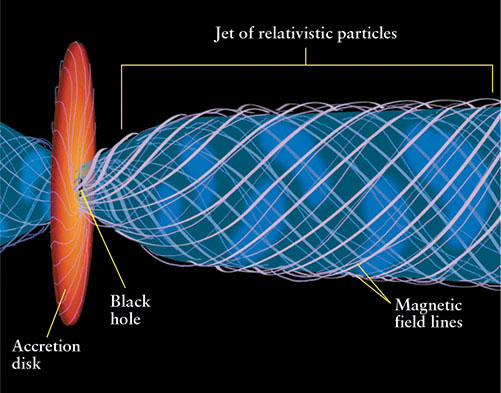
After traveling for hundreds of thousands of years or more, the jets of gas interact with enough preexisting interstellar and intergalactic gas to be spread out and eventually stopped, thereby forming the lobes and other features (see Figure 17-1a.) In 2003, astronomers using the Chandra X-ray Observatory observed gas jetting out from a supermassive black hole in a galaxy at the center of the Perseus cluster of galaxies and striking gas that resides between galaxies. This intracluster gas became compressed by the jet and generated concentric rings or shells of sound waves 35,000 ly in wavelength. Put another way, the sound created by the jet is a B-flat that is 57 octaves below middle C.
525
This “rocket nozzle” model explains not only double-radio sources—one coming out each side of the accretion disk—but also the jets and beams we see protruding from other active galaxies. We can now tie together all of the various objects discussed in this chapter. The major difference between the different types of active galaxies is the angle at which we view the central engine. As Figure 17-19 shows, an observer sees a radio galaxy or a double-radio source when the accretion disk is viewed nearly edge-on, because the jets are nearly in the plane of the sky. At a steeper angle, a quasar is seen. If one of the jets is aimed almost directly at Earth, the galaxy is a BL Lac object. The Seyferts, active spiral galaxies, are distinguished by whether we can see the bright core (Type 1) or not (Type 2). Their placements in Figure 17-19 are still under investigation.
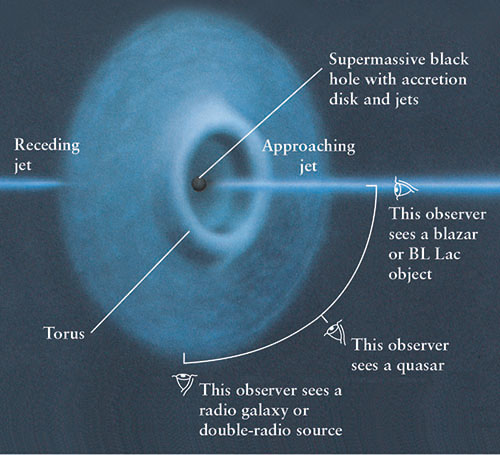
There are many active galaxies that we should see but do not. These objects have such thick and dusty accretion disks that little visible light or X-rays get through them. We cannot see the energy sources, for example, of quasars using visible light or X-ray telescopes in such situations. However, infrared radiation should pass through the gas and dust. Thus, in 2005, astronomers used the Spitzer Space Telescope to study regions of galaxies in which quasars should exist. In just one tiny patch of sky, they found 21 quasars. Extrapolating to the total volume of space that contains quasars, they expect “stealth” active galaxies to exist by the millions or more.
The other major factor in the observed properties of active galaxies and their evolutionary history is the amount of material available to make the accretion disk. Overlap in the brightness levels of different types of active galaxies occurs because central black holes and their accretion disks have different masses. The intensities of active galaxy emissions change as the amount of gas and dust in their accretion disks varies.
The amount of gas available in a galactic nucleus also changes with time. When supermassive black holes are young, they are surrounded by vast amounts of gas, which create massive accretion disks. Over time, much of this gas either enters the black hole or jets away from the disk, as just discussed. When an accretion disk is depleted, that active galaxy becomes more and more quiet. Because the galaxies we observe close to us are about the same age as the Milky Way, over 13 billion years old, their central black holes have already either consumed or ejected most of the gas and dust in their neighborhoods. Therefore, most have small or no accretion disks around the massive black holes in their nuclei, and hence they are no longer AGNs. Thus, we do not see many active galaxies close to us. However, when galaxies collide, gas can be available to enable quiet galaxies to once again become active.
Interestingly, the presence of an AGN causes the star formation rates in a galaxy to decrease, compared to the activity in the same galaxy without an AGN. The reason for this is that star formation occurs when gas and dust becomes Jeans’ unstable (see Section 5-2), a phenomenon that is sensitive to the temperature of the gas and dust. The cooler the debris is, the more susceptible it is to collapse and star formation. AGNs heat the gas in their galaxies, making it less able to collapse and form new stars. When an AGN turns off, the gas and dust throughout the galaxy cools and the star formation rate in it increases.
Occam’s Razor Revisited
It is possible to create separate theories for quasars, BL Lac objects, and other active galaxies. However, scientists prefer a comprehensive single theory that explains as many things as possible, because it incorporates common properties of the various phenomena. This search for simple, more powerful explanations is the central engine of progress in science.
526
17-6 Gravity focuses light from quasars
The radiation emitted by all quasars is subject to the gravitational lensing described by Einstein’s theory of general relativity (see Sections 14-3 and 16-11). Like the light from stars behind the Sun, the light from quasars is deflected as it travels past other galaxies or intergalactic gas and dark matter toward us. As we saw in Section 16-11, this gravitational lensing can lead to our receiving several images of objects. Figure 17-20 shows four images of a quasar in a configuration called an Einstein cross. See also Figure 16-29c. If the background object is exactly behind an intervening quasar, the light is actually focused as a ring, called an Einstein ring (see Figure 16-29b), rather than as several separate images.
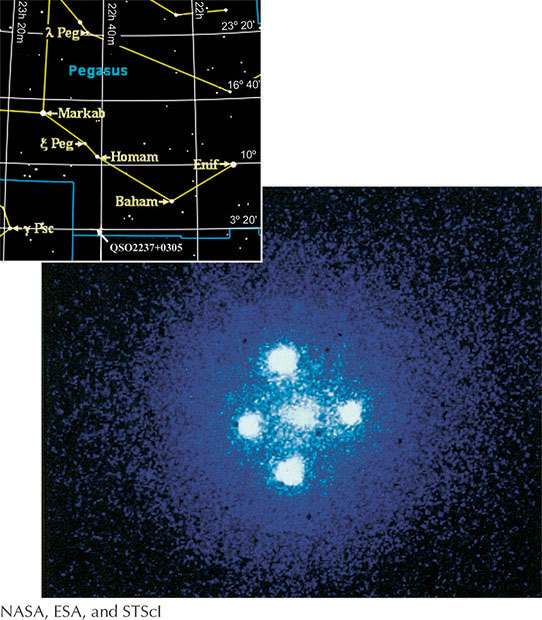
Margin Question 17-5
Question
What other astronomical objects have been observed after their light passed through a gravitational lens?
As you know, light travels at a finite speed. For example, light from the Sun takes about 8 minutes to reach Earth. We see the Sun as it was 8 minutes ago. As noted in Chapter 16, the farther an object is from us, the longer it takes light and other radiation from it to reach Earth. We see a galaxy 1 Bly away as it was a billion years ago. When we look at quasars, we are seeing objects as they appeared when the universe was younger still. In the last few years, astronomers using the Sloan Digital Sky Survey have discovered quasars at a distance corresponding to when the universe was only 770 million years old.
17-7 Frontiers yet to be discovered
Quasars, active galaxies, BL Lac objects, and double-radio sources are rich areas for observational and theoretical research. Why do different quasars emit most strongly in different parts of the spectrum? Are quasars an early phase of most galaxies, including the Milky Way, as many astronomers are coming to believe? What causes quasar variability? Do we have the proper explanations that blazars, quasars, and radio galaxies are caused by supermassive black holes seen from different orientations? How did supermassive black holes form so quickly in the life of the universe? New discoveries in this realm are being made nearly every week.